- Getting around Lijiang. Dont stay in the Old Towns more than 2 days, there is nothing to do. KRISS Oct 9, 2013 05:46
- 2013 Beijing Temple Fair BENNYLAU Feb 26, 2013 03:29
- Malaysian traveling from KUL - LAX vis Shanghai PVG ZATI_DY Jan 3, 2013 20:15
A Sunday in Suzhou
- Views: 8017
- |Vote: 3 0
- |Add to Favorites
- |Recommend to Friends
Why I love Sundays in China...
Sunday is probably my favourite day of the week in China. For those who work it is nearly the only day that is taken as a holiday and it is perhaps for this reason that there's always an extra jauntiness to the streets, an extra spring in the step and moreover, an even greater crowd than usual out and about.
There's a slight cessation of pace even with the increase in foot traffic, and the parks, gardens and shopping centres are full of families, children and couples. Sundays are like a pause in the monotony of working life, a time for play, a time for enjoyment, a time for meeting friends and family, gossiping, catching up or just floating along on a gentle cloud of free time for a while.
Make a trip on Sundays and you'll find city squares bursting with sound and activities, you'll find the old and the young, you'll find the sleepers and the watchers. For this reason alone, it's a great day to step out and let the flow of the tide take you where it will, immerse yourself in the restless meanderings of others and don't forget to keep a look out for secrets and surprises.
[image: gingko-edged road in Suzhou]
Fried Egg Pancakes & Canals...
It's Sunday in Suzhou. The street is lined with gingko trees whose fan-shaped leaves have turned the colour of gold and betray the fact that it's a November morning. There's a distinct chill in the air, a cool whisper that winter is approaching, and it's fortunate for me that I stumble across a popular street-vendor cooking up a delicious-smelling breakfast.
The morning stroll and dull weather heighten my appetite and I order a couple of the fried egg pancakes, watching with interest the rows of fried eggs snapping and the doughy pancake mixture browning temptingly. I thank the busily-cooking couple and move on with my fare, piping hot and stodgy.
It's not possible to walk far in the old city of Suzhou without coming across a canal. They bisect the city and run parallel with many of the main roads, creating small, still surprises in the course of a walk. This November day the water is reflecting the scene of gingkoes and catching the falling leaves.
Walking along the quieter canals feels like stepping back in time. The white washed two-storey houses that edge one side of the canal are a welcome respite to the average Chinese high-rise. On my side, the narrow lane is frequented with locals wearing broad Sunday-smiles and the overhanging trees make me feel a million miles away from modern China; the old city of Suzhou having managed to keep modernity somewhat at bay and preserved a sense of timelessness in these canal-lined streets.
[image: Suzhou canal]
Walking down Golden Lion Lane...
Not as numerous or famous as those of Beijing's hutong, but nevertheless the same narrow streets that offer a glance into ancient China can be found here in Suzhou.
One such street is the well-named Golden Lion Lane. In former times royal maids of honour would come here to pick the lotus flowers and admire the giant lotus pads floating in the ponds. The house of one of the top scholars in China during the reign of Emperor Qianlong also remains in the street.
Today the street is quietly flavoured with Sunday morning rituals. Washing hangs out across the alley, neighbours chatter and the occasional cyclist passes by. It's an intimate stroll that takes me down this lane and it's impossible not to look into some of the open windows and doorways. I catch a glimpse of Chinese life from time to time: a waft of breakfast cooking, an old couple deep in conversation, a baby crying.
[image: Golden Lion Lane... Sunday morning]
The Secret of 667 Renmin Road...
Renmin Road is one of the main roads that runs North/South through the old part of the city. I've walked here by chance and a high red wall rather like that surrounding the Forbidden City in Beijing blanks the view to my right. I notice ahead many walkers disappearing through a wooden doorway in the wall and I'm curious to see what lies behind it.
The number 667 hangs above the door that barely manages to keep itself upright it's so old. However, beyond the doorway I feel as though I've stepped into a magical land.
The floor is awash with polished stones, large and small, laid out upon black velvet-like blankets in bright rainbows of colour: blues, oranges, reds, greens, whites, greys. Not entirely Chinese-looking sellers sit on large cases or stand watch over the stones as locals finger the smooth surfaces and haggle over prices.
The vendors are from Xinjiang, many sporting beards and darker skins than their Suzhou compatriots and they are here to sell their wares in what I discover is actually a huge market laid out in the winding, old-style buildings that lie hidden behind the red wall.
I feel as though I've stumbled on a secret world of treasures, a flea-market of oddities. As bizarre an assortment of items for sale I don't think I've ever seen in one place: from precious stones to pottery, from coins to postcards, from jewellery to paintings, from the fake to the forged, from the ancient to the modern. I'm sure there's a bargain to be had here for those with an eye for such things.
I ask a vendor about a tiny clay figure of a Buddha that seems caked in earth. He tells me he dug it up with his own hands in Gansu Province and wants 50RMB for it. I wonder at its legitimacy. Even if it were real I think to myself, oughtn't it to be in a museum? I pass up the chance, though the figure remains in my mind, Buddha's rounded curves and timeless smile - I'm only half-surprised to find other identical ones further on.
From the roof corners above, the carved figures of two old men, one using a crutch and carrying a pigeon perched on his shoulder, the other holding a fan close to his fat belly, look carelessly down on the Sunday crowds coming, bartering and going in that age old tradition of buying and selling.
[image: market items for sale]
A Unique City Gate...
In hoping for glimpses of Suzhou's past in this 21st century version of the city, I hire a rickshaw to take me to the Southwest corner of the old city where the last remaining original gate within the city wall stands. It's now a "Grade AAAA National Tourist Attraction" and therefore worthy of a hefty 50RMB entrance fee.
I've no sooner paid the entrance fee than it begins to rain, a ruinous drizzle that soon blankets the place in mist and soaks everything. I'm glad I brought my umbrella.
The Coiled Gate is the last of the 6 gates that were originally built as part of the city wall. The section of the wall itself here stretches for only 300 metres and it's possible to walk along it and look out over the large canal that runs parallel.
The Coiled Gate is actually a unique invention that stands as the only one of its kind in China: a land and a water gate placed side by side. The water gate not only allowed boats two boats to pass underneath it when the portcullis was opened, but also acted as a sluice. It served the joint functions of being a defensive structure and a flood control. The land gate was composed of an inner and outer wall fitted with a tiny passageway for a quick getaway. Once the land and the water gates were closed, it was possible for a substantial military force to be held at bay.
It's sometimes difficult to remember the past in a present that seems to be ever eager to outrun it. Here at the city gate, I'm reminded of Suzhou's position as the ancient capital of the Wu Kingdom and as such that it was once under constant threat. The city wall has three canons, made in the Qing Dynasty, that face out over the battlements. A small sign tells of "canon fire licking up to the heavens and a cloud of smoke floating over the battlefield".
[image: looking along the city wall]
The Auspicious Light Pagoda...
The Coiled Gate is now part of a larger complex of gardens, ponds and pagodas. In the rain the spirit of the place is dampened considerably, but I can imagine it is beautiful on a fine day. In the centre is a large pool filled with Coi carp. On this murky day they look bright as fireworks, twisting and turning under the rain-patterned surface.
Standing boldly at the far end of the pool is the elegant 53 metre tall Auspicious Light Pagoda. The pagoda was built in 1004AD and is an octagonal structure comprised of 7 stories, each with a balcony. Even on this grim day I am eager to climb the tower and look out over the gardens from the top.
At the base of the tower a female Buddha figure is carved into the wall and many visitors have left coins in her alcove. I pass by her calm gaze without leaving an offering and ascend the pagoda's steep staircases. At the top I'm treated to a marvellous, rain-smudged view of the gardens beneath. It's possible to appreciate their symmetrical designs offsetting the central pool, and beyond the gardens the myriad white-walled, black-roofed houses cluster appealingly. I gaze for some time, reluctant to leave as the rain is now pounding heavily with newfound vigour.
I drop a coin into the Buddha's alcove on my exit, offering a quick prayer in the hope of changing my luck, and changing the weather, but it doesn't work. I exit the complex in torrential rain as a curtain of cloud descends to put an end to my Sunday in Suzhou.
[image: pagoda in the rain]
Information For Travellers (November 2007)
Please remember ticket prices are for November and therefore considered off-peak. It is possible prices will be higher if travelling during the more popular, peak seasons.
For details of the Master of Nets and Humble Administrator gardens in Suzhou, please see my review on this website by following this link: http://community.travelchinaguide.com/review2.asp?i=1244
Getting There:
From: Hangzhou East Bus Station
To: Suzhou South Bus Station
Cost: 65RMB
Entrance Prices:
Panmen or Coiled Gate Scenic Area
50RMB per person
Auspicious Light Pagoda
5RMB per person
The pagoda is within the Panmen Gate Scenic Area but is not covered by the Panmen Gate entrance ticket. You must pay extra if you want to climb it!
The market can be found every Sunday on Renmin Road.
[image: stones for sale at the market]



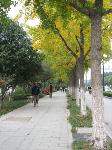


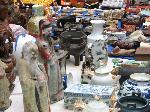
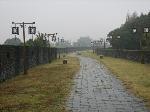
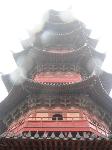
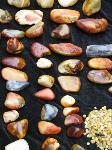
 Copyright © 1998-2025 All rights reserved.
Copyright © 1998-2025 All rights reserved.
1.
Apr 22, 2008 21:09 Reply
ALICIAYIYI said:
You can also come to visit the Tiger Hill in sozhou, it is very beautiful, and it is also a famous scenic spot with the its culture and a long history.